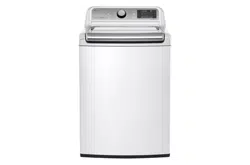Documents: Go to download!
- Owner's manual - (English, Spanish)
OWNER'S MANUAL Washing machine
FEATURES AND BENEFITS
KEY PARTS AND COMPONENTS
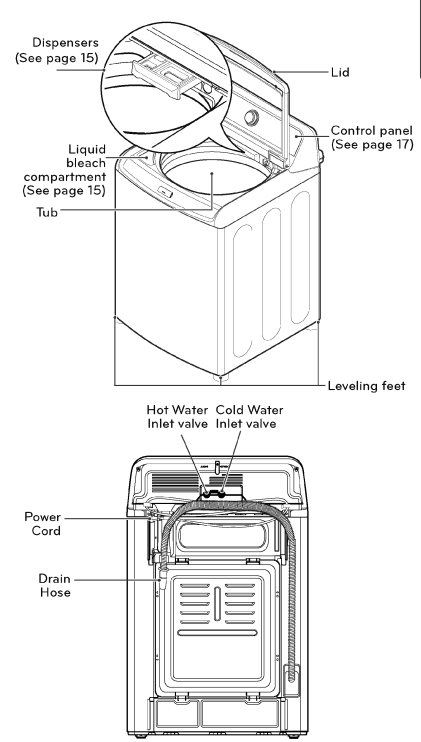
- A INVERTER DIRECT DRIVE MOTOR: The inverter motor directly connected to the tub produces less noise and vibration while offering outstanding durability with a longer lifespan.
- B ULTRA CAPACITY & NEVERUST™ STAINLESS STEEL TUB: The efficient design provides you with ultra large capacity but without making the cabinet larger or the drum any deeper for easy installation and use.
- Q TURBOWASH™: TurboWash™ reduces wash time without compromising performance. The precise drum movements and powerful water jets allow faster soaking, while the Smart Rinse™ Jet Spray allows quicker rinsing, saving you up to 20 minutes per load without sacrificing washing performance.
- D ALLERGIENE™: This powerful, high-temperature steam cycle is designed to reduce up to 95 percent of common household allergens such as dust mites and pet dander, and is certified by the Asthma and Allergy Foundation of America (AAFA).
- E REAR TOUCH PANEL: The easy to read LED display shows cycle options, setting, cycle status and estimated time remaining. The touch buttons offer more convenience and a premium design aesthetic.
- F SLAM PROOF™LID: The Slam Proof™ lid is a safety device that closes the lid slowly. The Slam Proof™ hinges allow the lid to close gently and quietly, helping prevent injuries.
- G SMART DIAGNOSIS™: If you ever experience an issue with your LG washer, you don't have to worry. The SmartDiagnosis™ feature helps the service center diagnose problems over the phone, or with a simple app on your smart phone, helping you minimize costly, inconvenient service calls.
PREPARATION
SORTING WASH LOADS
- CAUTION
- Do not load items higher than the top edge of the tub. Failure to follow this caution can result in leakage or damage to fabrics.
- Use the Bedding cycle for buoyant or nonabsorbent items such as pillows or comforters. Failure to follow this caution can result in leakage.
- If possible, do not wash any water-resistant items. If you must, please select the Waterproof cycle. (i.e. Water resistant clothing, mattress covers, outdoor clothes, plastic mats etc.)
- If waterproof material laundry is washed in a course other than Waterproof, it may result in injury or damage to the washer, clothes, walls, floor, and surrounding objects due to abnormal vibration.
- GROUPING SIMILAR ITEMS: For the best washing results, and to reduce the possibility of damage to clothing, care should be taken to sort the clothing into loads that are made up of similar items.
- Mixing different fabric types and/or soil levels can result in poor wash performance, color transfer, discoloration, fabric damage or linting. Fabrics should be sorted into groups as described below.
- COLORS: Sort articles by color. Wash dark clothes together in a separate load from light colors or whites. Mixing dark clothes with light clothes can result in dye transfer or discoloration of the lighter clothes.
- SOIL LEVEL: Wash heavily soiled clothing together. Washing lightly soiled clothing in the same load with heavily soiled clothing could result in poor wash performance for the lightly soiled clothing.
- FABRIC TYPE: Delicate articles should not be mixed with heavier or sturdier fabric types. Washing heavier fabrics in a delicate load can result in poor wash performance for the heavier fabrics and possible damage to the delicates.
- LINT TYPE: Some fabrics attract and bind lint to them while others give off lint in the laundry process. Avoid mixing these lint collectors and lint producers in the same load. Mixing these fabrics will result in pilling and linting on the lint collectors. (For example, lint collector - knit sweater; lint producer - terry cloth towels.)
SORT LAUNDRY...

FABRIC CARE LABELS
- Many articles of clothing include a fabric care label. Using the chart below, adjust the cycle and option selections to care for your clothing according to the manufacturer's recommendations.
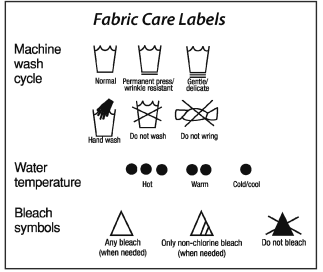
LOADING THE WASHER
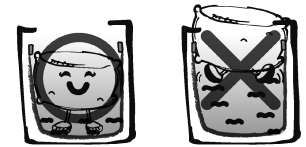
- Check all pockets to make sure that they are empty. Items such as clips, matches, pens, coins, and keys can damage both your washer and your clothes.
- Close zippers, hooks, and drawstrings to prevent these items from snagging or tangling on other clothes.
- Pretreat heavily stained areas for best results.
- Combine large and small items in a load. Load large items first.
- Large items should not be more than half of the total wash load.
- The washer can be fully loaded, but the tub should not be tightly packed with items. The lid of the washer should close easily.
- To prevent an out-of-balance load, do not wash single items. Add one or two similar items to the load. Large, bulky items, such as a blanket, comforter, or bedspread, should be washed individually.
- Waterproof items do wash or spin Waterproof cycle, (i.e. Water resistant clothing, mattress covers, outdoor clothes, plastic mats etc.)
- The washer will not fill or operate with the lid open
1. For best performance, load clothes as shown.
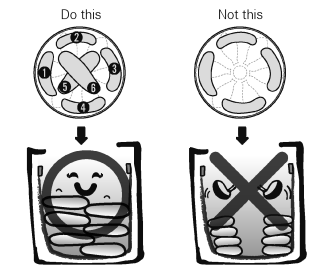
2. Load clothes loosely, and do not load clothes over the maximum guideline on the tub. Clothes need room to circulate in order to get clean.
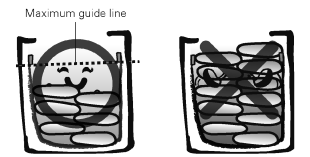
NOTE: Use the Bedding cycle for large or bulky items such as poly-filled jackets, comforters, pillows, etc. These items may not be as absorbent as other laundry items and should be sorted into a separate wash load for optimal results.
Bulky items should be placed as far down in the tub as possible for optimal results. Always place buoyant items at the bottom of the tub. The washer will automatically detect the load size. Because of the high-efficiency wash system, the water level may not completely cover the load.
ABOUT THE DISPENSERS
The automatic dispenser consists of two compartments which hold:
- Liquid fabric softener.
- Liquid or powdered detergent for the main wash
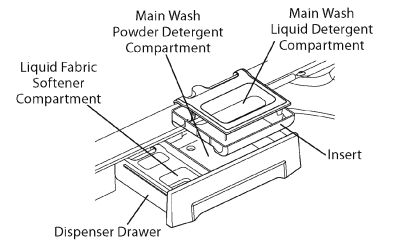
MAIN WASH DETERGENT COMPARTMENT
- This compartment holds laundry detergent for the main wash cycle. The detergent is added to the load at the beginning of the cycle. Always use High-Efficiency (HE) detergent with your washing machine. Either powdered or liquid detergent may be used.
- Never exceed the manufacturer’s recommendations when adding detergent. Using too much detergent can result in detergent buildup in clothing and the washer.
- When using liquid detergent, make sure the liquid detergent cup and insert are in place. Do not exceed the maximum fill line.
- When using powdered detergent, remove the liquid detergent cup from the compartment. Powdered detergent will not dispense with the liquid detergent cup in place.
FABRIC SOFTENER COMPARTMENT
This compartment holds liquid fabric softener, which is automatically dispensed during the final rinse cycle.
Never exceed the manufacturer's recommendations when adding softener. Using too much fabric softener can result in damage to clothing and the washer. Either powdered or liquid fabric softener.
- Always follow the manufacturer’s recommendations when adding fabric softener. Do not exceed the maximum fill line. Using too much fabric softener may stain clothes.
- Dilute concentrated fabric softeners with warm water. Do not exceed the maximum fill line.
- Never pour fabric softener directly onto the load or into the tub
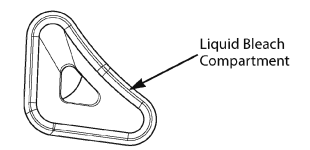
LIQUID BLEACH COMPARTMENT
The bleach dispenser is a separate compartment at the left front of the tub opening. This compartment holds liquid bleach, which is dispensed automatically at the proper time during the wash cycle. Any liquid remaining in the dispenser at the end of the cycle is water, not bleach.
- Do not add powdered bleach to this compartment. The bleach compartment is designed to dispense liquid bleach only. Powdered or liquid color-safe bleach will not dispense properly.
- Always follow the manufacturer's recommendations when adding bleach. Never add more than one cup and do not exceed the maximum fill line since this can cause the bleach to be dispensed immediately, resulting in damage to fabrics. Using too much bleach can damage fabrics.
- Never pour undiluted liquid chlorine bleach directly onto the load or into the tub. Fabric damage can occur.
- Do not use color-safe bleach or Oxi products in the same cycle with liquid chlorine bleach.
DANGER
- Do NOT mix chlorine bleach with ammonia or acids, such as vinegar or rust/scale remover. Mixing chemicals like these can produce a lethal gas, resulting in severe injury or death.
DETERGENT AND DISPENSER USE A WORD ABOUT DETERGENTS
- High-Efficiency (HE) detergents produce fewer suds, dissolve more efficiently to improve washing and rinsing performance, and help to keep the interior of your washer clean. Using detergent that is not HE may cause oversudsing and unsatisfactory performance which could result in error codes, cycle failure, and machine damage.
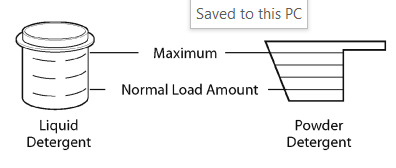
- For proper wash performance, always measure the detergent using the measuring device provided by the detergent manufacturer.
- The normal amount of FIE detergent needed, for average loads, is less than Yz of the recommended maximum. Use less detergent for soft water, light soil or smaller loads. Never use more than the maximum amount recommended by the detergent manufacturer.

IMPORTANT: Your washing machine is designed for use with only High-Efficiency (FIE) detergents. HE detergents are formulated specifically for High-Efficiency washers and contain suds-reducing agents. Always look for the HE symbol when purchasing detergent.
IMPORTANT: Not all detergents are the same. Pay careful attention to the amount of detergent used to avoid oversudsing, poor rinsing and detergent buildup in clothing, and residue buildup that can contribute to odors in the machine. NEVER use a cup or scoop other than the one supplied by the manufacturer of the detergent you are using. Never use more than the maximum amount of detergent recommended by the manufacturer. A full scoop or measure of detergent should only be used for very large and heavily soiled loads. Using too much detergent can result in detergent buildup in the washer and in your clothes.
Always measure the detergent amount. While HE detergents are designed for this type of washing machine, be careful when measuring the detergent. For most normal loads, no more than 1/4 to 1/2 a cap or scoop of HE detergent should be used.
NOTE:
- Extra care must be exercised when using 2X and 3X concentrated detergents because even a little bit extra can contribute to the problems mentioned above.
- Detergents designated as HE compatible may not provide optimal results.
USING THE SOFTENER AND DETERGENT DISPENSER
To add detergent, and fabric softener to the automatic dispenser:
- Open the dispenser drawer.
- Load the laundry products into the appropriate compartments.
- Close the drawer before starting the cycle.
- If using fabric softener on NORMAL or FIEAVY DUTY cycles, press the FABRIC SOFTENER button or select the EXTRA RINSE option.
NOTE: It is normal for a small amount of water to remain in the bleach dispenser and softener compartment at the end of the cycle.
IMPORTANT: Do not place or store laundry products, such as detergent, bleach, or liquid fabric softener, on top of your washer or dryer. Wipe up any spills immediately. These products can damage the finish and controls.
USING THE LIQUID BLEACH DISPENSER
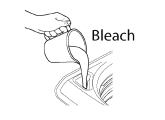
The bleach dispenser automatically dilutes and dispenses liquid bleach at the proper time in the wash
See other models: LSXS26396S GSX960NSAZ LUPXS3186N WD205CK DLEX9500K
cycle.
- Check clothing care labels for special instructions.
- Measure liquid bleach carefully, following instructions on the bottle. High-efficiency washers use less water, so less bleach is needed. One half cup is enough for most loads.
- Carefully pour the pre-measured amount of bleach directly into the bleach dispenser. If you are using powdered bleach of any kind, pour it directly into the tub before adding the laundry. Never add powdered bleach to the liquid bleach dispenser.
- Never pour undiluted liquid chlorine bleach directly onto clothes or into the tub.
- Do not pour powdered bleach into bleach dispenser.
- Do not place laundry items on top of the bleach dispenser when loading and unloading the washer.
- Always measure and pour bleach carefully. Avoid overfilling or splashing when adding bleach to the dispenser. The maximum capacity of the bleach dispenser is one cup of bleach per wash cycle. Overfilling could result in bleach being dispensed immediately, which can result in damage to the clothes in the washer.
HOW TO USE
CONTROL PANEL FEATURES

- A POWER (ON/OFF) BUTTON: Press to turn the washer ON. Press again to turn the washer OFF. Pressing the POWER button during a cycle will cancel that cycle and any load settings will be lost. The lid will unlock after a brief pause.
NOTE: If there is any water remaining in the tub after the washer shuts off, it will drain following 4-minutes delay. The washer can be restarted any time before the drain begins. However, once the water begins to drain, all functions will be suspended until the water has been completely drained and the washer shuts off.
- B CYCLE SELECTOR KNOB: Turn this knob to select the desired cycle. Once the desired cycle has been selected, the standard presets will appear in the display. These settings can be adjusted using the cycle setting buttons any time before starting the cycle.
NOTE: To protect your clothing, not all settings are available on all cycle selections.
- C START/PAUSE BUTTON: Press this button to start the selected cycle. If the washer is running, use this button to pause the cycle without losing the current settings.
NOTE: If you do not press the START/ PAUSE button within 60 minutes of selecting a cycle, the washer automatically turns OFF and all cycle settings are lost. And any water remaining in the tub will be drained.
- D CYCLE MODIFIER BUTTONS: Use these buttons to adjust the settings for the selected cycle. The setting lights above the buttons illuminate to show the current selection.
- E SPECIAL CYCLE AND OPTION BUTTONS: These buttons allow you to select special cycles or options.
- F TIME AND STATUS DISPLAY: The display shows the cycle status and estimated time remaining.
TIME AND STATUS DISPLAY
The time and status display shows the estimated time remaining and cycle progress.
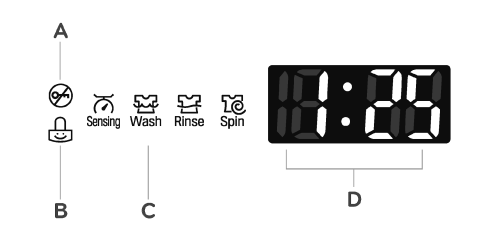
- A LID lock indicator: The Lid Lock indicator will illuminate once a cycle has started. The indicator light will stay on until the cycle is paused, stopped or has finished.
- B CHILD LOCK: When the Child Lock function is activated, the LED lights up. When the Child Lock function is set, except for the POWER button, the other functions are disabled. Once the Child Lock function is disabled, the LED will turn off.
- C CYCLE STATUS INDICATOR: These LEDs will illuminate when a cycle is selected to indicate which stages will run. When a cycle is running, the LED for the active stage will blink, and the LEDs for the remaining stages will remain steady. Once a stage is complete, the LED will turn off. If a cycle is paused, the active stage LED will stop blinking.
- D ESTIMATED TIME REMAINING: When a cycle is selected, the default time for that cycle is displayed. This time will change as modifiers or options are selected. Once the START/PAUSE button is pressed, the washer will measure the size of the load. The estimated time may change once the load size has been measured. If Delay Wash is set, the remaining delay time counts down until the cycle begins.
NOTE: The time shown is only an estimate. This time is based on normal operating conditions. Several external factors (load size, room temperature, incoming Water temperature, water pressure, etc.) can affect the actual time.
OPERATING THE WASHER
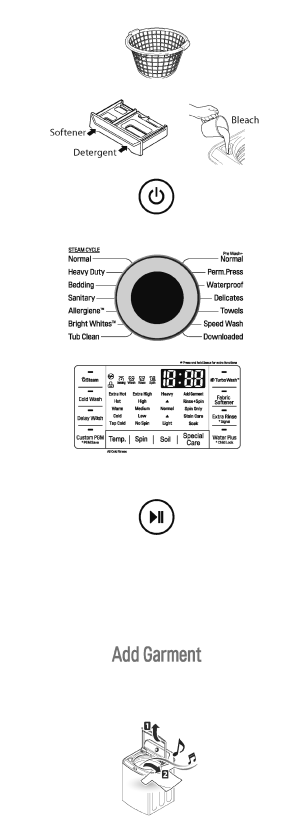
- 1 SORT LAUNDRY AND LOAD THE WASHER: Sort laundry by fabric type, soil level, color and load size, as needed. Open the lid and load items into the washer.
- 2 CLEANING PRODUCTS: Add High-Efficiency (HE) detergent to the detergent dispenser. If bleach or fabric softener is to be used, add these to the appropriate dispensers.
- 3 TURN ON THE WASHER: Press the POWER button to turn ON the washer. The lights around the cycle selector knob will illuminate and a chime will sound.
- 4 SELECT A CYCLE: Turn the cycle selector knob in either direction to select the desired cycle. The preset Wash Temp., Spin, Soil, Special Care and option settings for that cycle will be shown. Pressing the Start Pause button without selecting a cycle will cause the Normal cycle to begin immediately.
- 5 ADJUST SETTINGS: Default settings for the selected cycle can now be changed, if desired, using the cycle modifier and option buttons.
NOTE: Not all modifiers and options are available on all cycles. A different chime will sound and the LED will not come on if the selection is not allowed.
- 6 BEGIN CYCLE: Press and hold the START/PAUSE button to begin the cycle. The lid will lock, and the washer will agitate briefly without water to measure the weight of the load. If the START/PAUSE button is not pressed within 60 minutes, the washer will shut off and all settings will be lost.
- 7 ADD GARMENT LIGHT: The Add Garment light will illuminate near the beginning of the wash cycle to indicate when it is safe to add items to the load. Press the START/ PAUSE button to pause the cycle and add garments to the load. Press the START/PAUSE button to resume the cycle.
NOTE: It is not recommended to add items unless the Add Garment light is illuminated, as this could result in poor performance and/or clothing damage.
- 8 END of cycle: When the cycle is finished, a melody will sound. Immediately remove your clothing from the washer to reduce wrinkling.
CYCLE MODIFIER BUTTONS
- Each cycle has default settings that are selected automatically. You may also customize these settings using the cycle modifier buttons. Press the button for the desired modifier until the indicator light for the desired setting is lit. The washer automatically adjusts the water level for the type and size of wash load for best results and maximum efficiency. Due to the high-efficiency nature of this product, water levels may be much lower than expected. This is normal and cleaning/rinsing performance will not be compromised.
- NOTE: To protect your garments, not every wash/ temperature, spin speed, soil level, or option is available with every cycle. A chime will sound and the LED will not light if a selection is not allowed
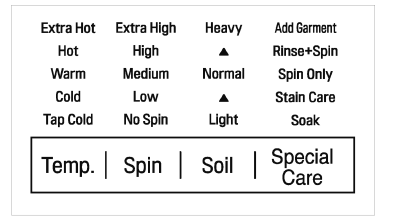
Temp.: Temp, selects the wash and temperature combination for the selected cycle. Press the Temp, button until the indicator light for the desired setting is lit. All rinses use tap cold water.
- Select the water temperature suitable for the type of load you are washing. Follow the garment fabric care labels for best results.
Spin
- Higher spin speeds extract more water from clothes, reducing drying time and saving energy.
- Press the Spin button until the desired speed is selected. Some fabrics, such as delicates, require a slower spin speed. To protect your clothing, not all spin speeds are available for all cycles.
Soil
- Adjusting the soil level setting will modify the cycle times and/or wash actions. Press the Soil button until the desired soil level is selected.
- NOTE: This feature needs more time for heavily soiled loads or less time for lightly soiled loads.
SPECIAL CARE
- Pressing the SPECIAL CARE button will allow you to select additional features, such as Soak, Stain Care, Spin Only, and Rinse+Spin. Pressing the SPECIAL CARE button before selecting a cycle will automatically default to the Normal cycle with the Soak feature selected.
SPECIAL CARE
After selecting a cycle, press the SPECIAL CARE button to select additional features for your load.
NOTE:
- To protect your garments, not every feature is available with every cycle.
- If the START/PAUSE button is not pressed within 60 minutes to start the cycle, the control will shut off and all settings will be lost.
SOAK
- This option provides 30-minutes presoak prior to the start of the selected cycle. Use the SOAK option to presoak garments to help remove difficult spots or stains on fabrics. At the end of the presoak time, the selected cycle will begin with the same water used for the soak.
- NOTE: You cannot select the SOAK option in the TUB CLEAN and ALLERGIENE™ cycles or with the STEAM option selected.
STAIN CARE
- Use this option for heavily soiled loads that need improved stain treatment. When Stain Care is selected, the wash cycle will begin with warm water to help prevent the setting of certain types of stains. Then, as the cycle progresses, hot water will be added to gradually increase the water temperature to help remove stains that require treatment at higher temperatures.
- NOTE:
- Best results are obtained with smaller loads (less than 6 lbs.)
- If you select STAIN CARE, the COLDWASH option is not available.
SPIN ONLY: Use this option to drain the water from the tub and spin out the clothes. This can be used, for example, if the wash cycle is interrupted by a power failure. The spin speed can be adjusted by using the SPIN SPEED button.
- Press the POWER button to turn on the washer.
- Press the SPECIAL CARE button repeatedly until Spin Only is selected.
- Press the Spin button to select the desired spin speed. Selecting NO SPIN is not allowed.
- Press the START/PAUSE button.
RINSE-)-SPIN: Select this option to rinse and spin a load separately from a regular cycle. This can be helpful in preventing fresh stains from setting in fabrics. You can change the spin speed by pressing the SPIN SPEED button.
- Press the POWER button to turn on the washer.
- Press the SPECIAL CARE button until the Rinse+Spin indicator light is lit. (The cycle light will turn off.)
- Press the START/PAUSE button to start the cycle.
SPECIAL DRAIN FEATURE:
- This washer is equipped with a special feature that is designed to make your washer as safe as possible. If the washer is paused or shut off while there is still water in the tub, the water will drain automatically after several minutes of inactivity. This helps keep children safe by reducing the possibility of water remaining in the tub.
- Any water remaining in the tub will automatically drain 4 minutes after the washer has shut off. If the washer is paused and the START/PAUSE button is not pressed within 60 minutes, the washer will shut off and all cycle settings will be lost. And any water remaining in the tub will be drained.
- The washer can be turned on or restarted any time before the drain begins. However, once the washer begins to drain, all controls and functions will be disabled until the water has been completely drained and the washer shuts off.
OPTION BUTTONS
Your washing machine features several additional cycle options that customize cycles to meet your individual needs. To use these options, select the desired option AFTER selecting the desired cycle.
After selecting the desired cycle and settings, press the cycle option button(s) for the option(s) you would like to add. The button will light when that option is selected. If the selected option is not allowed for the selected cycle, the chime will sound twice to alert you and the LED will not illuminate.
NOTE:
- To protect your garments, not every option is available with every cycle.
- If the START/PAUSE button is not pressed within 60 minutes to start the cycle, the control will shut off and all settings will be lost.
STEAM
- Adding the Steam option to a wash cycle helps provide superior cleaning performance. By using hot steam, the fabrics will get the cleaning benefits of a very hot wash.
WARNING
- Do not touch the lid during steam cycles. The lid surface can become very hot. Allow the lid lock to release before opening the door.
- Do not attempt to override the lid lock mechanism or reach into the washer during a steam cycle. Steam can cause severe burn
NOTE:
- The steam option cannot be used with all cycles.
- The STEAM option is automatically deselected if Turbo Wash™ is selected for the NORMAL, HEAVY DUTY.SANITARY, and BRIGHT WHITE™ cycles.
- Steam may not be clearly visible during the steam cycles. This is normal. Too much steam could damage clothing.
- Do not use steam with delicate fabrics such as wool, silk, or easily discolored fabrics.
COLD WASH
- This option saves energy by using cold water while increasing the wash and rinse times to maintain wash performance.
- NOTE:
- The Stain Care feature cannot be selected with the Cold Wash option.
- Wash time will increase up to 50% with the Cold Wash option.
- For best wash results, only wash small loads (less than 8 lbs.) with the Cold Wash option.
DELAY WASH:
- Once you have selected the cycle and other settings, press this button to delay the start of the wash cycle. Each press of the button increases the delay time by 1 hour, for up to 19 hours. Once the desired delay time is set, press the START/PAUSE button to start the delay time.
- NOTE: If the START/PAUSE button is not pressed to begin the delay time, the washer will automatically shut off after 60 minutes and all cycle settings will be lost.
CUSTOM PROGRAM (PGM): Custom Program allows you to store a customized wash cycle for future use. It allows you to save your favorite temperature, spin speed, soil level, and other options for a cycle, and then recall them at the touch of a button. To create a Custom Program:
- Press the POWER button to turn on the washer.
- Turn the cycle selector knob to select the desired cycle.
- Press the cycle modifier button to change the desired setting.
- Press the cycle option button to add the desired options.
- Press and hold the Custom PGM button for 3 seconds.
TO RECALL A CUSTOM PROGRAM:
- Press the POWER button to turn on the washer.
- Briefly press the Custom PGM button. The stored settings will display.
- Press the START/PAUSE button to start the cycle. (Pressing any other button at this time will cancel the Custom Program.)
NOTE: You may only save one custom program at a time. Pressing and holding the Custom PGM button will overwrite any previously saved custom program.
TURBO WASH™: Adding the Turbo Wash™ option reduces the cycle time while still providing similar wash performance to the same cycle without Turbo Wash™.
NOTE:
- The Turbo Wash™ option cannot be used with all cycles.
- Turbo Wash™ defaults ON for NORMAL, Pre Wash+NORMAL and SPEED WASH cycles.
- Turbo Wash™ is automatically deselected for NORMAL, HEAVY DUTY, BRIGHT WHITES™ and SANITARY cycles if the STEAM option is selected.
FABRIC SOFTENER
- The fabric softener is dispensed in the final rinse. Select the Fabric Softener button if you are using fabric softener.
EXTRA RINSE
- This option will add an extra rinse to the selected cycle. Use this option to help ensure the removal of detergent or bleach residue from fabrics. Liquid fabric softener, if used, is always dispensed in the final rinse.
- NOTE: You cannot select the Extra Rinse option with the Spin Only option and Tub Clean cycle.
WATER PLUS
- Use this option to add extra water to the wash cycle for better wash performance(Stain Treatment) with large items.
- NOTE: If the washing machine reaches its maximum water level, the Water Plus button will have no effect.
SIGNAL
- The washing machine plays a melody when the wash cycle has finished. The volume of the melody is adjusted using the Extra Rinse button.
- Press and hold the Extra Rinse button for 3 seconds to adjust the volume of the signal. Press and hold the button repeatedly to adjust the volume of the melody. When no signal is heard, the signal is off. The volume settings are LOW - HIGH - OFF. The signal volume can be adjusted at any time as long as the washer is turned ON.
CHILD LOCK
- Use this option to disable the controls. This feature can prevent children from changing cycles or operating the machine. Once the Child Lock is set, it must be deactivated before any controls, except the power button, can be used. Once the washer has shut off, the power button will allow the machine to be turned ON, but the controls will still be locked. When the controls are locked, CL will display alternately with the estimated time remaining.
- Press and hold the Water Plus button for 3 seconds to activate or deactivate Child Lock.
- NOTE: Once the controls are locked, they must be manually unlocked to restore operation.
ADD GARMENT: Laundry may ONLY be added to the load at the proper time in the wash cycle. When the Add Garment light is illuminated, it is safe to pause the cycle and add more items to the load. If garments are added when the Add Garment light is off, the washer will not adjust for these items which could result in poor performance and/or fabric damage.
- Press the START/PAUSE button to pause the washer.
- Open the lid after it unlocks.
- Add your additional items.
- Close the lid.
- Press the START/PAUSE button. The cycle will resume after the lid locks.
CARE AND CLEANING
WARNING: To reduce the risk of fire, electric shock, or injury to persons, reed and follow this entire Owner's Manual, including the Important Safety Instructions, before operating this washer.
- Unplug the washer before cleaning to avoid the risk of electric shock. Failure to follow this warning can cause serious injury, fire, electric shock, or death.
- Never use harsh chemicals, abrasive cleaners, or solvents to clean the washer. They will damage the finish.
REGULAR CLEANING
CLEANING THE EXTERIOR
- Proper care of your washer can extend its life. The outside of the machine can be cleaned with warm water and a mild, nonabrasive household detergent. Immediately wipe off any spills with a soft, damp cloth.
- IMPORTANT: Do not use solvents, cleaning alcohols, or similar products. Never use steel wool or abrasive cleaners because they can damage the surface.
CARE AND CLEANING OF THE INTERIOR
- Use a towel or soft cloth to wipe around the washer lid opening and lid glass.
- Always remove items from the washer as soon as the cycle is complete. Leaving damp items in the washer can cause wrinkling, color transfer, and odor. Run the Tub Clean cycle once a month, or more often if needed, to remove detergent buildup and other residue.
TUB CLEAN CYCLE
- Some environmental and usage conditions can cause a residue to build up in the tub over time and can lead to a mildewy or musty smell. The Tub Clean cycle is specially designed to remove this buildup using bleach or other cleaners designed specifically for cleaning washing machines. Run the Tub Clean cycle once a month, or more often under heavy use conditions or if odor is present
- Remove any clothing from the tub.
- Fill the bleach dispenser to the MAX line with liquid chlorine bleach. Do not overfill the bleach dispenser. Overfilling will cause the bleach to dispense immediately. NOTE: For other tub cleaning products, follow the cleaner manufacturer's instructions and recommendations. For powdered cleaning products, add the cleaner to the main wash compartment of the dispenser drawer after removing the liquid detergent dispenser insert.
- Close the lid and press the POWER button to turn the washer ON. Turn the knob to select the Tub Clean cycle then press the START/PAUSE button to begin the cycle. Selecting any other cycle after Tub Clean has been selected will cause the Tub Clean cycle to be cancelled.
- After the cycle ends, open the lid and allow the tub interior to dry completely.
NOTE:
- Never load laundry while using TUB CLEAN. The laundry may be damaged or contaminated with cleaning products. Make sure to run the Tub Clean cycle ONLY when the tub is empty.
- It is recommended to leave the lid open after finishing the laundry to keep the tub clean.
- It is recommended that Tub Clean should be repeated monthly.
REMOVING MINERAL BUILDUP
- If you live in an area with hard water, mineral scale can form on internal components of the washer. Use of a water softener is recommended in areas with hard water.
- Use a descaler, to remove visible mineral buildup. After descaling, always run the Tub Clean cycle before washing clothing.
- Mineral scale and other spots may be removed from the stainless steel tub using a stainless steel cleaner. Do NOT use steel wool or abrasive cleaners.
LEAVE THE LID OPEN
- If the washer will not be used for several days, leave the lid open overnight to allow the tub to dry.
MAINTENANCE
CLEANING THE WATER INLET FILTERS
- If the washer does not fill properly, an error message will show on the display. The inlet valve filter screens could be plugged by hard water scale, sediment in the water supply, or other debris.
- NOTE: The inlet screens protect the delicate parts of the inlet valve from being damaged by particles that could enter the valves with the water supply. Operating the washer with these filters removed could cause a valve to stick open resulting in flooding and/or property damage.
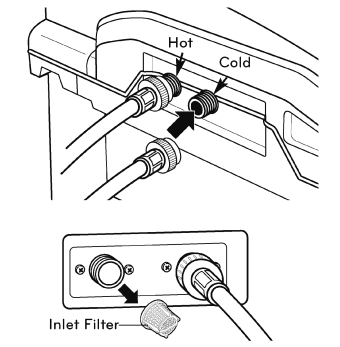
- Turn OFF both water faucets completely. Unscrew the hot and cold water lines from the back of the washer. IMPORTANT: Aftermarket hoses are not guaranteed to fit or function correctly. Other hoses may not tighten correctly and could cause leaks. Subsequent damage to product or property will not be covered under the terms of the product warranty.
- Carefully remove the filters from the water valves and soak them in white vinegar or a lime scale remover, following the manufacturer's instructions. Be careful not to damage the filters while cleaning.
- Rinse thoroughly before reinstalling. Press the filters back into place.
- Before reattaching the hoses, flush the hoses and water lines by running several gallons of water into a bucket or drain, preferably with the faucets wide open for maximum flow.
NOTE: IE message may blink on the display when the water pressure is weak or an inlet filter is clogged with dirt. Clean the inlet filter.
WARNING
- Unplug the power cord and turn off the faucets before cleaning. Failure to do so may cause electric shock.
- Do not use the washing machine without the inlet filters. If you use the washing machine without the inlet filters it will cause leaks and product malfunction.
- If you use the washing machine in an area with hard water, the inlet filter may clog due to lime buildup.
- Certain internal parts are intentionally not grounded and may present a risk of electric shock only during servicing. Service personnel-do not contact the followingparts while the appliance is energized.: pump, motor.noise filter cover, and heater (on applicable models).
STORING THE WASHER: If the washer will not be used for an extended period of time and is in an area that could be exposed tof reezing temperatures, perform the following steps to protect the washer from damage.
- Turn OFF the water supply.
- Disconnect the hoses from the water supply and drain water from the hoses.
- Plug the power cord into a properly grounded electrical outlet.
- Add 1 gallon of nontoxic recreational vehicle (RV) antifreeze to the empty tub and close the lid. Never use automotive antifreeze.
- Press the POWER button, then select Spin Only. Press the START/PAUSE button to activate the drain pump. Allow the drain pump to run for one minute, then press the POWER button to shut off the washer. This will expel some of the antifreeze, leaving enough to protect the washer from damage.
- Unplug the power cord, dry the tub interior with a soft cloth, and close the lid.
- Remove the inserts from the dispenser. Drain any water in the compartments and let them dry.
- Store the washer in an upright position.
- To remove the antifreeze from the washer after storage, run a complete Speed Wash cycle using detergent. Do not add laundry to this cycle.
CLEANING THE WASHER PROPER USE OF DETERGENT
- Using too much detergent is a common cause of laundry problems. Today's detergents are formulated to be effective without visible sudsing. Be sure to carefully read and follow manufacturer’s recommendations for how much detergent to use in your wash. You can use less detergent if you have soft water, a smaller load, or a lightly soiled load.
- NOTE: Use only low-sudsing, high-efficiency detergent. These detergents can be identified by the HE iogo.

WARNING: *Do not spray water inside the washing machine. Doing so may cause fire or electric shock
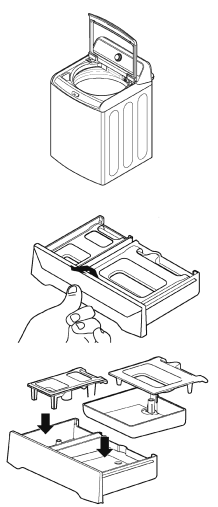
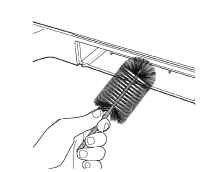
CARE AND CLEANING OF THE WASHER
- Lid: Wash with a damp cloth on the outside and inside and then dry with a soft cloth.
- Exterior: Immediately wipe off any spills. Wipe with a damp cloth. Do not touch the surface or the display with sharp objects.
- Moving and Storage: Contact a service technician to remove water from the drain pump and hoses. Reinstall the foam tub block to protect the washer from damage while moving. Do not store the washer where it will be exposed to outdoor weather conditions.
- Long Vacations: Be sure the water supply is shut off at the faucets. Follow the instructions in the Storing the Washer section if the washer will be exposed to freezing temperatures.
- Dispenser Drawer: Detergent and fabric softener may build up in the dispenser drawer. Remove the drawer and inserts and check for buildup once or twice a month.
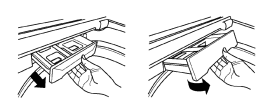
- Remove the drawer by pulling it straight out until it stops. Lift up on the front of the drawer and pull it completely out.
- Remove the inserts from the two compartments. Rinse the inserts and the drawer with warm water to remove buildup from laundry products.
- To clean the drawer opening, use a small, non-metal brush to clean the recess. Remove all residue from the upper and lower parts of the recess.
- Return the inserts to the proper compartments and replace the drawer. Set the drawer into the opening at an angle as shown above, then lower it and slide it into place.
SPECIFICATIONS

TROUBLESHOOTING
NORMAL SOUNDS YOU MAY HEAR
- The following sounds may be heard while the washer is operating. They are normal.
- CLICKING: Lid lock relay when the lid locks and unlocks.
- SPRAYING OR HISSING: Water spraying or circulating during the cycle.
- HUMMING OR GURGLING: Drain pump is pumping water from the washer at times during a cycle.
- WATER SLOSHING SOUND: A liquid in the balance ring around the wash basket helps the basket spin smoothly.
- SOUND OF WATER BEING ADDED AFTER THE WASHER HAS ALREADY BEEN IN OPERATION
- The washer adapts to the load size and type to add more water to the cycle as needed.
- The wash load may be unbalanced. If the washer senses that the load is unbalanced, it will stop and refill to redistribute the load.
- The washer may be diluting laundry additives to add to the wash load.
BEFORE CALLING FOR SERVICE
Your washing machine is equipped with an automatic error-monitoring system to detect and diagnose problems at an early stage. If your washer does not function properly or does not function at all, check the following before you call for service:
| Problem | Possible Cause | Solutions |
| Rattling and clanking noise |
Foreign objects, such as keys, coins, or safety pins may be in tub |
Stop washer, check tub for foreign objects. If noise continues after washer is restarted, call for service. |
| Thumping sound |
Heavy wash loads may produce a thumping sound. Wash load may be out of balance. |
This is normal. If sound continues, washer is probably out of balance. Stop and redistribute wash load. Pause the cycle and redistribute the load after the lid unlocks |
| Vibrating noise |
Packaging materials were not removed. Wash load may be unevenly distributed in the tub. Not all leveling feet are resting firmly and evenly on the floor. Floor not rigid enough |
See the Unpacking and Removing Shipping Material section in the installation requirements section. Pause the cycle and redistribute the load after the lid unlocks. See Leveling the Washer in the Installation Instructions section. Make sure that the floor is solid and does not flex. See Flooring in the Installation Requirements section. |
| Water leaking |
Inlet hose connection is loose at faucet or washer. House drain pipes are clogged. Drain hose has come out of drain or is not inserted far enough. A large item such as a pillow or blanket is above the top of the tub. |
Check hoses for leaks, cracks and splits. Check and tighten hose connections. The washer pumps out water very rapidly. Check for water backing up out of the drain pipe during drain. If water is seen coming out of the drain, check for proper drain hose installation and check for restrictions in the drain. Contact a plumber to repair drain pipe. Tie drain hose to inlet hose or standpipe to prevent it from coming out during drain. For smaller drain pipes, insert the drain hose into the pipe as far as the drain hose flange. For larger drain pipes, insert thedrain hose into the pipe 1-2 inches past the flange. Use the BULKY/BEDDING cycle for large or bulky items. Use extra care and never wash more than half a load of items that float, such as pillows. Stop the washer and check the load. Make sure the load does not crest above the top edge of the tub. |
| Wrinkling |
Washer not unloaded promptly. Washer overloaded. Hot and cold water inlet hoses are reversed. |
Always remove items from the washer as soon as the cycle is complete. The washer can be fully loaded, but the tub should not be tightly packed with items. The lid of the washer should close easily. Hot water rinse can set wrinkles in garments. Check the inlet hose connections. |
| Excessive sudsing | Too much detergent or incorrect detergent. |
HE detergents are formulated specifically for High-Efficiency washers and contain suds-reducing agents. Only use detergent with the High-Efficiency (HE) logo. For detergent guantities refer to the How to Use section. |
| Staining |
Bleach or softener dispensed too soon. Bleach or softener was added directly to the wash load in the tub. Washer was not unloaded promptly- Clothes were not properly sorted. |
Dispenser compartment is overfilled causing bleach or softener to dispense immediately. ALWAYS measure bleach to prevent overfilling - one cup maximum. Dispenser drawer closed too quickly causing softener to dispense immediately. Always use the dispensers to ensure that laundry products are properly dispensed at the right time in the cycle. Always remove items from the washer as soon as possible after the cycle is complete. Always wash dark colors separately from light colors and whites to prevent discoloration. Never wash heavily soiled items washed with lightly soiled items. |
| Washer will not turn ON |
Power cord is not properly plugged in. House fuse is blown, circuit breaker has tripped, or power outage has occurred |
Make sure that the plug is plugged securely into a grounded, 3-prong, 120-VAC, 60-Hz outlet. Reset circuit breaker or replace fuse. Do not increase fuse capacity. If the problem is a circuit overload, have it corrected bv a gualified electrician |
| Wash cycle time is longer than usual | The washer automatically adjusts the wash time for the amount of laundry, water pressure and other operating conditions. | This is normal. The washer adjusts cycle time automatically to provide optimal results for the selected cycle. The time remaining shown in the display is only an estimate. Actual time may vary. |
| Musty or mildewy odor in washer |
Incorrect or too much detergent has been used. Inside of tub was not cleaned properly |
Use only High-Efficiency (HE) detergent in accordance with the manufacturer's instructions. Run the Tub clean cycle regularly |
| Water leaks | Oversudsing of detergent. | Oversudsing may create leaks, and may be caused by the type and amount of detergent used. High-Efficiency detergent is the only detergent recommended. Make sure that detergent and any additives are put into the correct dispenser compartments. The normal amount of detergent to use is 1/4 to 1/2 of the maximum amount recommended by the detergent manufacturer. Always reduce the amount of detergent if the load is small or lightly soiled, or if your water is very soft. Never use more than the maximum amount recommended by the detergent manufacturer |
| Washer will not operate |
Controls panel has powered off due to inactivity Washer is unplugged Water supply is turned off. Controls are not set properly. Lid is open Circuit breaker/fuse is tripped/ blown Control needs to be reset. START/PAUSE was not pressed after a cycle was set Extremely low water pressure. Washer is too cold.
|
This is normal. Press the POWER button to turn the washer on Make sure cord is plugged securely into a working outlet. Turn both hot and cold faucets fully on Make sure the cycle was set correctly, close the lid and press the START/PAUSE button. The washer will not operate if the lid is open. Close the lid and make sure that nothing is caught under the lid preventing it from closing completely Check house circuit breakers/fuses. Replace fuses or reset breaker. The washer should be on a dedicated branch circuit. The washer will resume the cycle where it stopped once power is restored Press the POWER button, then re-select the desired cycle and press the START/PAUSE button. Press the POWER button then re-select the desired cycle and press the START/PAUSE button. The washer will shut off if the START/PAUSE button is not pressed within 60 minutes Check another faucet in the house to make sure that household water pressure is adequate. If the washer has been exposed to temperatures below freezing for an extended period of time, allow it to warm up before pressing the POWER button. Otherwise, the display will not come on.
|
| Washer not filling properly |
Filter clogged. Inlet hoses may be kinked. Energy efficiency. Insufficient water supply. The washer lid is open Hot and cold inlet hoses are reversed Water level is too low. |
Make sure the inlet filters on the fill valves are not clogged. Refer to the filter cleaning instructions Check that inlet hoses are not kinked or clogged. This is a High Efficiency (HE) washer. As a result, the water level settings for this washer may be different than for conventional washers. Make sure that both hot and cold water faucets are turned on all the way The washer will not operate if the lid is open. Close the lid and make sure that nothing is caught under the lid preventing it from closing completely Check inlet hose connections. Make sure the hot water supply is connected to the hot inlet valve, and the cold water supply is connected to the cold inlet valve. This is a high efficiency washer. The water will not normally cover the clothes. The fill level is optimized for the wash motion to achieve the best wash performance |
| Washer will not drain water |
Kinked drain hose. Drain located higher than 96 in. above the floor |
Ensure that the drain hose is not kinked. Make sure that the drain hose is no higher than 8 ft. above the bottom of the washer and is no more than 5 ft. away from the washer. |
| Poor stain removal |
Proper options not selected. Previously set stains. |
Heavier soils and tougher stains may require extra cleaning power. Select the Soak or Stain Care feature to boost the cleaning power of the selected cycle. Articles that have previously been washed may have stains that have been set. These stains may be difficult to remove and may require hand washing or pretreating to aid in stain removal. |
| Bleach does not dispense |
Bleach dispenser cover is not properly installed. Bleach dispenser is dirty or clogged. |
Make sure that the bleach cover is properly installed and snapped into place before the beginning of the cycle. Lift out the bleach dispenser cover and clean out the reservoir. Lint and other foreign debris that collects in the inside the dispenser may prevent proper dispensing of the bleach |
| Premature dispensing of bleach |
Bleach dispenser filled for future load. Overfilling the bleach dispenser |
You cannot store bleach in the dispenser for future use. The bleach will be dispensed every load. Overfilling the bleach dispenser will cause the bleach to dispense immediately, which will damage items in the tub. ALWAYS measure bleach, but never fill above the MAX line on the dispenser. One cup of bleach is normal, but never add more than one cup. |
| Incomplete or no dispensing of detergent |
Detergent compartments clogged from incorrect filling. Too much detergent used. Insufficient water supply. Normal residue |
Make sure that detergent and additives are put into the correct dispenser compartments. If liquid detergent is used, make sure that the liquid detergent cup and insert are in the detergent compartment. If powdered detergent is used, make sure that the liquid detergent cup and insert are not used. For all detergent types, always make sure that the
dispenser drawer is fully closed before the start of the cycle. Make sure that the suggested amount of detergent is used per the manufacturer's recommendations. You may also dilute the detergent with water to the maximum fill line on the compartment to avoid clogging. Use only HE (High- Efficiency) detergent. NOTE: Always use as little detergent as possible. High-Efficiency washers need very little detergent to achieve optimum results. Using too much detergent will cause poor wash and rinse performance and may contribute to odors in washer. Make sure that both hot and cold water faucets are turned on all the way. It is normal for a small amount of detergent to remain in the dispenser. If this residue builds up it can interfere with normal dispensing of products. Refer to the cleaning instructions. |
| Water leaks every load | Hoses not installed correctly | Check all fill and drain hose connections to ensure that they are tight and secure |
|
The display shows: |
The lid is not closed properly. |
Make sure that the lid is closed properly and press the START/PAUSE button. After starting a cycle, it may take a few moments before the tub begins to turn or spin. The washer will not spin unless the lid is locked. If the lid is closed and the lid lock error message is displayed, call for service |
The display shows:  |
Lid lock switch error. |
Make sure that the lid is closed properly and press the START/PAUSE button. The washer will not operate unless the lid is locked.
Make sure that nothing is caught under the lid, including shipping material or clothing. Make sure that the latch mechanism is fully retracted. If the lid is closed and the lid lock error message is displayed, call for service. |
The display shows:  |
Special Drain Feature | If the washer is paused during a cycle for more than 4 minutes, the cycle will be cancelled and any water remaining in the tub will be drained. This code is not an error code, but is the function display for notification only |
|
Washer fills with water slowly or not at all, or the display shows: |
Water supply faucets are not fully open. Water line hoses are kinked, pinched, or crushed. Water inlet filters are clogged. Water supply pressure to faucet or house is too low. Water supply connected with leak-limiting hoses. |
Make sure that the water faucets are fully open. Make sure that the hoses are not kinked or pinched. Be careful when moving the washer during cleaning and maintenance. Clean the inlet filters. See Maintenance in the Care and Cleaning section. Check another faucet in the house to make sure that household water pressure is ad-eguate and flow is not restricted. Disconnect the inlet hose from the washer and run a few gallons of water through the hose to flush the water supply lines. If flow is too low, contact a plumber to have the water lines repaired. Hoses designed to limit leaks can trip falsely and prevent the washer from filling. The use of leak limiting hoses is not recommended. |
| Washer will not turn on |
Power cord is not properly plugged in. House fuse is blown, circuit breaker has tripped, or power outage has occurred |
Make sure that the plug is plugged seruely into a grounderd, 3-prong. 120-VAC, 60-Hz. outlet. Reset circuit breaker or replace fuse. Do not increase fuse capacity. If the problem is a circuit overload, have it corrected by a qualified electrician. |
The display shows:  |
Foreign objects, such as coins, pins, clips, etc., caught between the wash plate and the inner basket. |
Turn off the washer and then press the Power button. Press the spin speed button without selecting a cycle to drain and spin the load. When the spin is complete, remove the clothes and then find and remove any objects caught in the wash plate. Always check pockets, etc., before washing to prevent error codes or damage to the washer or clothing. |
Water in the washer drains slowly or not at all, or the display shows:  |
Drain hose is kinked, pinched, or clogged Drain hose is kinked, pinched, or clogged |
Make sure the drain hose is free of clogs, kinks, etc., and is not pinched behind or under the washer. Adjust or repair drain. Maximum drain height is 96 inches (8 ft.) |
The display shows:  |
The washer has detected an out of balance load. | If the washer detects a load that is too far out of balance to spin, it will display this code while it is attempting to rebalance the load. The washer will add water and try to redistribute the load automatically. As a result, the cycle will take longer than initially estimated. This display is for your information only, and no action is required. |
The display shows:  |
If the UE rebalancing operation (see above) is not successful, this error will be displayed. The load is too small. Heavy articles are mixed with lighter items. The load is out of balance. |
The automatic attempt to rebalance the load was not successful. The cycle has been paused to allow the load to be manually adjusted. Small loads may need additional items to be added to allow the washer to balance the loads. The load may have heavy items loaded with lighter items. Always try to wash articles of somewhat similar weight to allow the washer to evenly distribute the weight of the load for spinning. Manually redistribute the load if articles have become tangled preventing the automatic distribution from working properly. |
The display shows:  |
Control error. | Unplug the washer and wait 60 seconds. Reconnect power and try again. If the error reappears, call for service. |
The display shows:  |
Water level is too high due to a faulty water valve. | Close the water faucets, unplug the washer, and call for service. |
The display shows:  |
Water level is too high due to a faulty water valve. | Close the water faucets, unplug the washer, and call for service. |
The display shows:  |
A motor error has occurred | Allow the washer to stand for 30 minutes and then restart the cycle. If the LE error code persists, call for service. |
The display shows:  |
Clutch error. |
Mechanical failure. Unplug the washer and call for service. |


